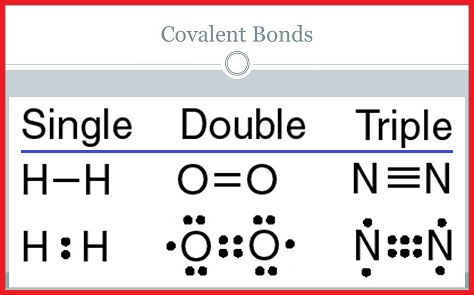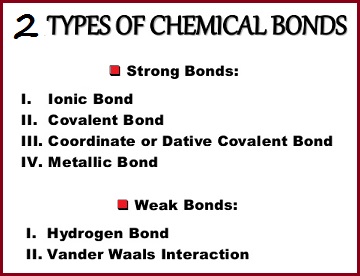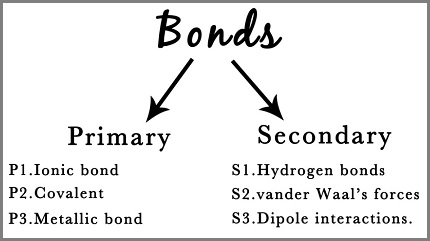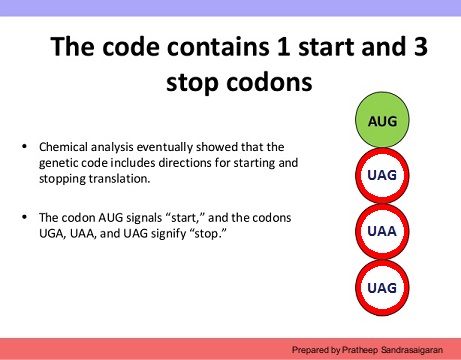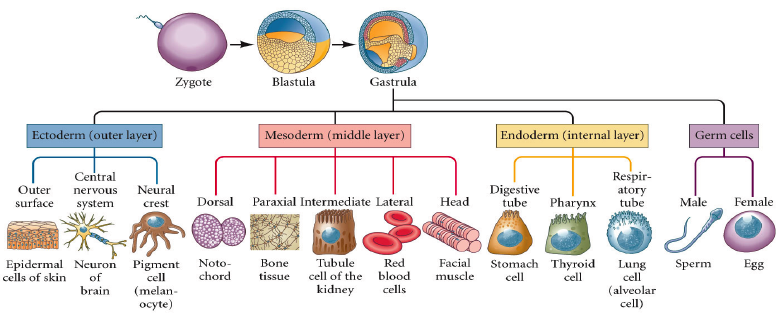page 3
~ The Study of Threes ~
http://threesology.org
Visitors as of 4/06/2023
| The Triplet Code 1 | The Triplet Code 2 | The Triplet Code 3 | The Triplet Code 4 |
(Continued from page 2.)
- 3 types of covalent chemical bonds: single- double- triple
- 3 to 1 ratio of bonds related to CHON but is somewhat reversed to be read as the "HONC (1234) rule":
 Slider Base Presentations: Molecular bonding |
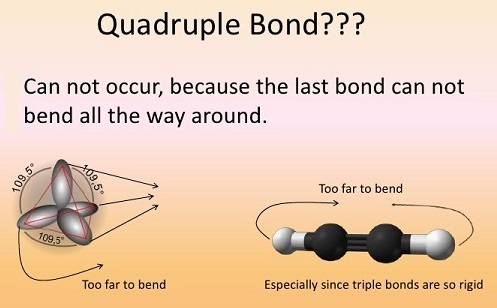 Covalent Bonding (slide #36)> |
- 3 main types of chemical bonds perspective: Covalent- Ionic- Hydrogen
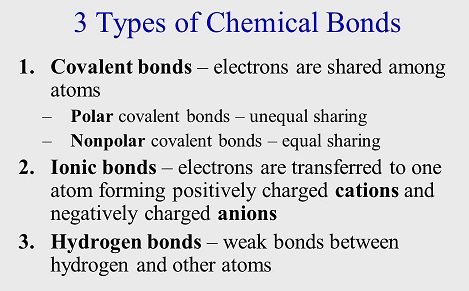
- 2 Types of chemical bonds perspective: Weak and strong
- 2 types of chemical bonds perspective: Primary and Secondary
- 4 types of chemical bonds: Ionic- Covalent- Polar- Hydrogen
 Chemistry Explained: Bonding |
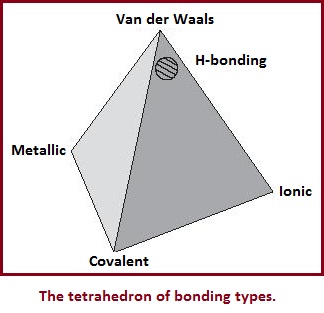 |
- 3 classes of exceptions to the octet rule (Chemical Bonds, Lewis Symbols, and the Octet Rule):
- Molecules with an odd number of electrons
- Molecules with one or more atoms with less than an octet
- Molecules with one or more atoms with more than an octet
- 3 branches to the U.S. government (though a Peoples Legislative Branch is needed which would make the current 3 branch system a 3-to-1 configuration):
- 3 US clothing sizes: Small- Medium- Large
- 3 US school grade variations: A+, A, A- (plus, neutral, minus)
- 3 US public school levels: primary, secondary, tertiary (Elementary- Middle/Jr. high- High school)
- 3 typical grades of gasoline, with diesel as a fuel oil... thus giving us a 3-to-1 ratio
- 3 divisions to clocks: Seconds- Minutes- Hours
- 3 animal nutrition types: Carnivore (Meat eating)- Omnivore (Plant and Meat eating)- Herbivore (Plant eating)
- 3 divisions of insects: Head- Thorax- Abdomen
- 3 classes in honey bee societies: Worker- Queen- Drone
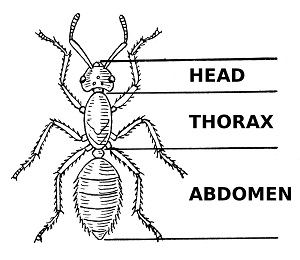 |
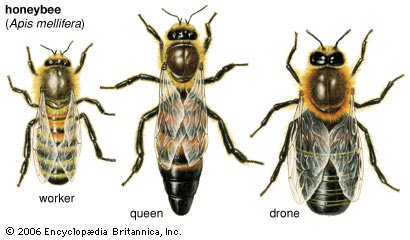 |
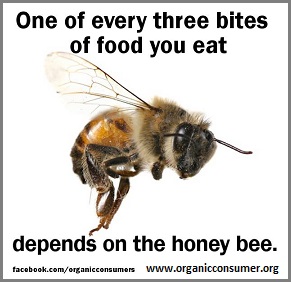 |
- 3 general classes in human societies: Upper- Middle- Lower (Divisions sometimes multiplied by sub or inter-categorization, like adding X-large, XX-Large, XXX-large to the category of "large")
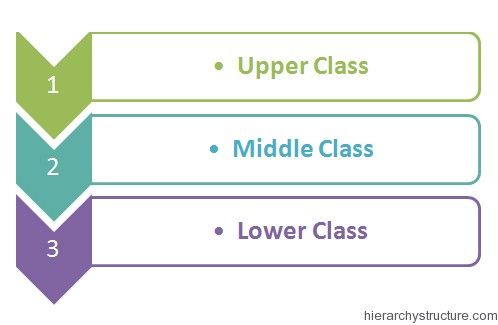
- 3 classes to the old guild system
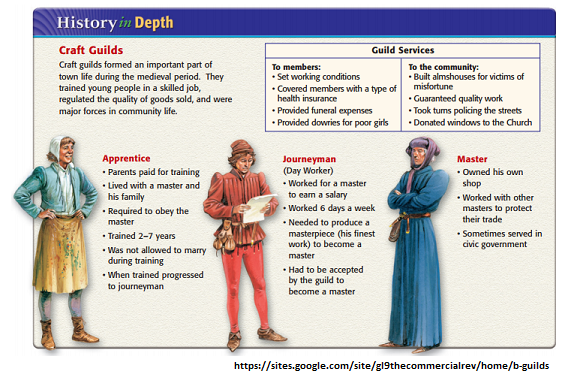
These three divisions can be used to illustrate the presence of political guilds in society today:
- 3 reading frames for every strand of genetic material
- 3 STOP codons and 1 START codon in amino acids
- 3 main types of cells perspective versus a perspective which sees two types of basic cells:
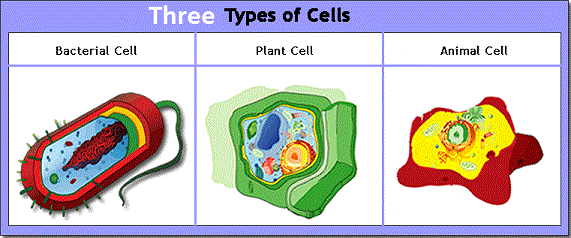 Cells and Cell Processes |
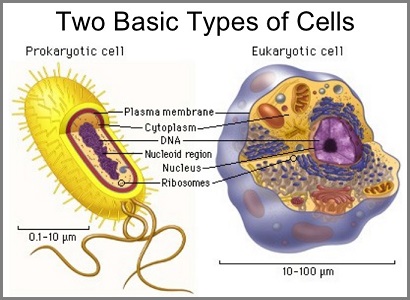 Basic Cell types |
- 3 components of nucleic acids: a 5-carbon sugar, a phosphate group, and a nitrogenous base
- 3 Germ layers: Endoderm- Mesoderm- Ectoderm
- 3 life domains: Archaea- Bacteria- Eucaryota
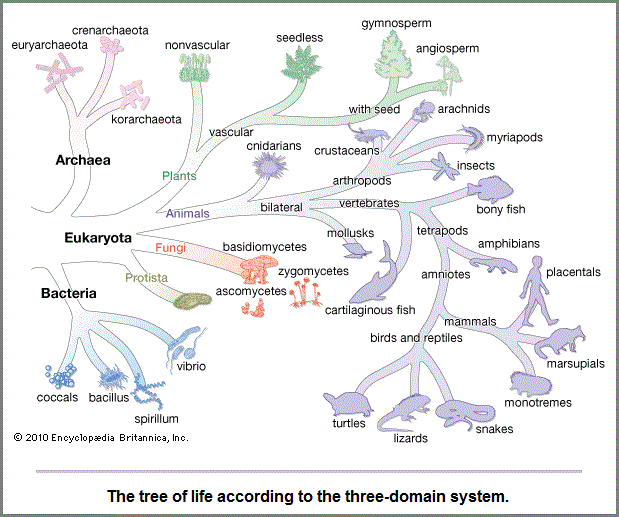
- etc...
Did an underlying triple scaffolding actually precede the development of amino acids to which they were required to conform to? If so, what then could possibly have trigged the development of a triple scaffolding? And does this serve as the primary influence for the usage of other "three-patterned" configurations found in other subject areas? And what of those recurring patterns (in different subjects) which do not express a triple pattern such as are called dichotomies, pairs, dimers, bifacial, chirality, acid/base, quadratic, five, six, seven, etc.?
First, let's tackle the question of what may have influenced the proposed idea of a triple scaffolding that amino acids were forced to abide with as they came to develop. While we mostly speculate about early Earth conditions that the basic building materials of life were subjected to, there is at present only one distinguishable... or at least obvious event which expressed a recurring pattern-of-three. Taking into consideration a low or absent oxygen atmosphered coupled with a low or absent ozone and an increased rotation of the Earth, the present of the Sun's effects in terms of a three-patterned dawn- noon- dusk ("moments") interval may well have been that created a "branded" image. Hence, the triplet code is a brand name of where our particular type of genetics was manufactured.
|
Have changes in the rotation rate of the Earth influenced biological development in a fashion which replicates such an impression; thereby giving another "tweaking" of the definition to the phrase: That God made man in his image, by describing How God did it? Is it a three-patterned image (formula) somehow related to the changes in the Earth's rotation rate in relation to the auxiliary consequential effects?
Keep in mind that the faster accelerated rates occurred prior to the advent of recognizable life forms (plants/animals), but that the precursors of the building blocks of life (DNA, Proteins, RNA) were subjected to such. | ||||||||||||||||||||
|
Pattern-of-1 Overlapping daylight period was due to a vastly accelerated rotation rate: |
Pattern-of-2 Night/Day-sequence was due to Earth's slowing rotation: |
Pattern-of-3 Triangle image "Flashing" of Dawn~ Noon~ Dusk was due to further slowing: | ||||||||||||||||||
|
|
| ||||||||||||||||||
These "patterns" are related to the intensity and duration of illumination as well as darkness, which are key influences of biological processes. Growth and sustaining life is dependent on periods of light and dark, how much sunshine, how much shade, etc... However, we cannot dismiss such things as planetary polarity reversals, electro-magnetic field strength/weakness and gravitation shifts as having no influence. With respect to gravity, it is speculated that one of the influences in the evolutionary development of the heart is due to changes in gravity, with more gravity requiring a stronger heart, and a change in gravity thus affects the types of species inhabiting the land at that time. We should also consider the possibility that isolated "pockets" or "pools" (niches, crevices, caves, etc.) of one or more phenomena may occur, thus inviting and nurturing the development of one or more species some may want to label as being mutations, but are merely habitat specific. Additionally, "pocket" or "pool" might refer to a small or large area. |
||||||||||||||||||||
Related source materials:
pyramid page 1
pyramid page 2
Sun rays page 1
Sun rays page 2

Along with the 3-patterned strobe-like event of the Sun's three intense "moments" (or moments which created three distinctive environmental conditions), we find that both the paths of the Sun and Moon create triangular images that biological forms have been subjected to since before their first appearance. In other words, the path of the Sun and Moon do not exhibit "across the sky" (linear) nor "over the sky" (circular/dome) patterns except in human language references to inaccurate perceptions. This includes a recognition of the influential night/day, cold/warm, wet/dry, etc. dichotomies to be included in our developing equation of philosophy. However, while we can clearly identify some life forms expressing a "three" pattern such as the three-chromosome identity of highly valuable grains, we sometimes can not see such a pattern and may view the presence of some other pattern that catches our eye and others become convinced this particular pattern is to be used as a dominant theme of recognition. Also, let us make mention of the presence of a "three" as the result of an identifiable maturational sequence, such as that seen in what is called "incomplete metamorphosis" (egg, nymph, adult) and what is called "complete metamorphosis" which has four stages of development that we can alternatively refer to as 3-to-1 ratios, though other species can be viewed as having more than four stages.
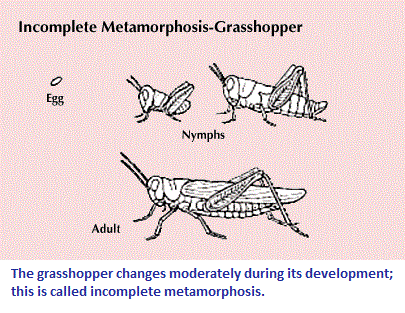 |
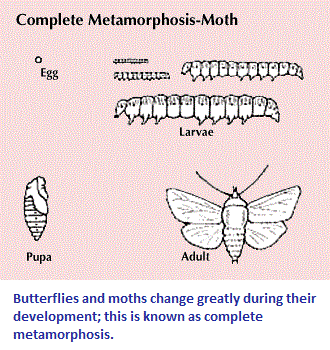 |
One might interpret the idea that multiple stages reflect something that is "complete" and hence, correct— and "incomplete" as being incorrect; whereby applying this to changes in a person that happen quickly as being unusual... or even suspicious and wrong. So if you become a genius over night, there is something wrong with you because you must proceed along a path of development agreeable to those who in society are enabled to decide what is the correct and proper course.
In biology, (metamorphosis refers to) striking change of form or structure in an individual after hatching or birth. Hormones called molting and juvenile hormones, which are not species specific, apparently regulate the changes. These physical changes as well as those involving growth and differentiation are accompanied by alterations of the organism's physiology, biochemistry, and behaviour. The immature forms, or larvae, are adapted to environments and modes of life that differ from those of the adult forms. These differences may be of significance in assuring that larvae and adults of the same species do not engage in direct competition for food or living space. Examples of metamorphosetis include the tadpole, an aquatic larval stage that transforms into the land-dwelling frog (class Amphibia). Starfishes and other echinoderms undergo a metamorphosis that includes a change from the bilateral symmetry of the larva to the radial symmetry of the adult. Metamorphic patterns are well-known in crabs, lobsters, and other crustaceans and also in snails, clams, and other mollusks. The larval form of the urochordate (e.g., the tunicate, or sea squirt) is tadpole-like and free swimming; the adult is sessile and somewhat degenerate. Among the most dramatic and thoroughly studied examples of metamorphosis are the insects. Because development is not the same in all insects, it is convenient to group them into major categories according to the pattern of structural changes: ametabolous, hemimetabolous, and holometabolous. In ametabolous development there is simply a gradual increase in the size of young until adult dimensions are attained. This kind of development occurs in the silverfish, springtail, and other primitive insects. In more advanced insects (e.g., grasshoppers, termites, true bugs) a phenomenon known as gradual, or hemimetabolous, metamorphosis occurs. The hemimetabolous life cycle consists of egg, nymph, and adult. The nymph, or immature insect, resembles the adult in form and eating habits, differing in size, body proportions, and colour pattern. Rudimentary wings are visible and develop externally. Development is gradual through a series of molts (periodic shedding of the outer skeleton), the adult emerging from the final molt. Complete, or holometabolous, metamorphosis is characteristic of beetles, butterflies and moths, flies, and wasps. Their life cycle includes four stages: egg, larva, pupa, and adult. The larva differs greatly from the adult. It is wingless, and its form and habits are suited for growth and development rather than reproduction. The change to the adult occurs during the inactive, non-feeding pupal stage. At this time the larva undergoes a transformation in which the wings appear externally, larval organs and tissues are broken down, and adult structures are developed. Hypermetamorphosis, a form of complete metamorphosis, occurs in some beetles, flies, and other insects and is characterized by a series of larval stages. Source: "metamorphosis." Encyclopædia Britannica Ultimate Reference Suite, 2013. |
With respect to metamorphosis, here is another 3-to-1 ratio in that there are three "conveniently labeled" typical types (ametabolous, hemimetabolous, holometabolous) and one auxiliary form (holometabolous). Also note that there is a geometric-structural change in some from a bilateral (linear) symmetry to a radial (circular) one which aligns with the notion of a linear- circular- triangular developmental array such as seen in linear-shaped trees harboring low or sea level areas, circular-shaped (fully foliaged) trees at increased elevations, and triangular-shaped trees like the pine, at higher altitudes:
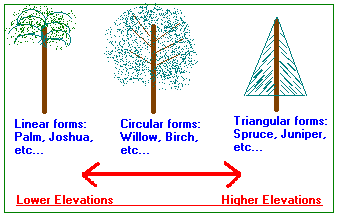 |
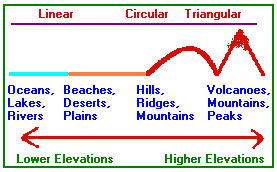
|
Linear, Circular, Triangular page 1
While the idea of amino acids having occurred as the result of some metamorphosis is not typically encountered, the idea of evolution within a primordial soup or porridge is. But irrespective of which word and accompanying notions you choose to use, both events occur within environmental constraints. And though you may not like the idea that the triplet code occurred due to some easily identifiable environmental event that is changing due to planetary degradations... you may or may not react negatively to the view that such a circumstance presents us with the possibility that the triplet code may be forced to adapt to three incremental changes involving heat energy, geo-dynamo, ocean waves, night/day circadian rhythms, winds, ozone, etc...:
- The Sun is burning out and is thought to proceed along a path of expansion to engulf the innermost three planets.
- The Earth's rotation is slowing.
- The Moon is receding.
Since humanity came onto the Earthly landscape during a specific time during the Earth's rotation, this may well signal that humanity is rotation rate-specific, in that as the rotation rate changes, humanity's ability to adapt to the change is limited. See this page for a reference to the discussion: Are Humans Rotation Rate Specific? page 1
No doubt some readers will jump on the bandwagon of those whose knee-jerk response to the above three incremental deteriorations is to claim that they are processes which will take billions of years. Yet, the situation is one in which one's perspective must be turned inside out to get a clearer picture. For example, while many minds look at the effects a speeding bullet (or any object) has on an obstruction, not too many observers visually hold the bullet in a motionless state and accelerate the obstruction (or target). What this proposes is that most view humanity as the virtually motionless obstruction in terms of its life span. However, if we contrast it to the life span of say a Redwood or other long-living tree, we thus more readily note that the human life span is relatively short and in addition, do not readily show tree-ring growth patterns related to environmental conditions. Metaphorically speaking, though such ring-like recordings are to be found in our evolutionary trek, comparing fossils alone is not enough of a tale-tell sign. Such a view requires that we take into consideration the changes in technology, speech, medical treatment, military armaments, building codes, construction codes, clothing, religious beliefs, etc... The problem though is that it is difficult to discern incremental changes as one might want to observe them in a graph-like form. While we may speak of progress, we must also speak in terms of degradation or relative equilibrium and the different ways in which they can be illustrated in behavior as opposed to biology and physiology. Hence, incremental deterioration would exhibit itself in what can be called "rationalized adjustments".
If we use the metaphor of a raft(s) to describe human civilization pit against the incremental deteriorations of the planetary system, one might suggest that it is the outer edges of the raft(s) which will first feel the effects, just as if it was the first part to face the ravages of external conditions such as reefs, aggressive sea creatures, rocks, other rafts, etc... And those who live on the "fringes" of society will no doubt view the world from their perceptions of what they are subjected to, while those who huddle closer to the "politically correct" status-quo middle, will have a different perception. So when someone on the fringes of society carries a placard claiming that the world is coming to an end, they may well be telling the truth from their perception, if not in fact projecting an insightful premonition about their own forth-coming demise like Stephen Hawking did. He in fact lived on the fringes of a society that those in business, government and religion were wholly too involved with center-of-the-raft activities to take any notice of.
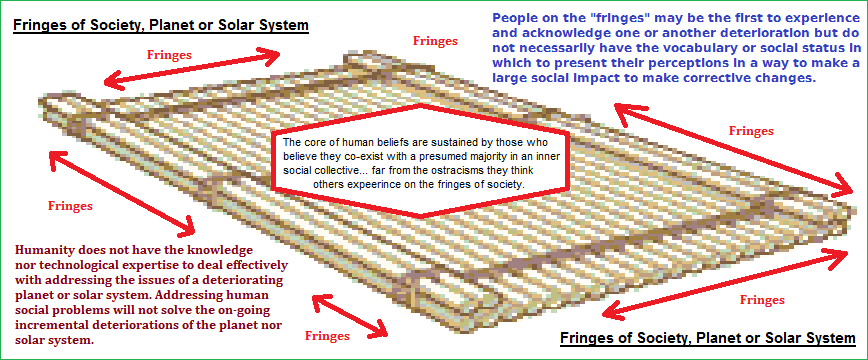
Let's Talk Peace page 58
Page Originated: Saturday, 7th April 2018... 7:53 AM
Initial Posting: Thursday, 12th April 2018... 10:57 AM
Updated Posting: Saturday, 22nd June 2019... 8:32 AM
